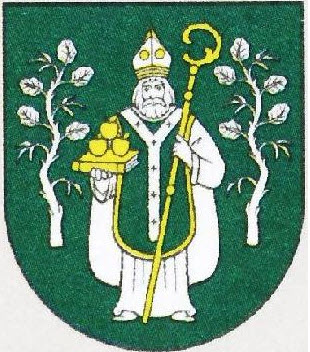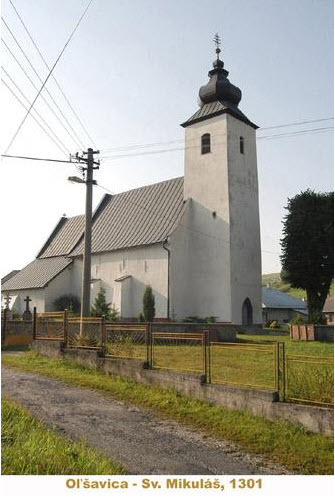
Historical records show this village first being mentioned in the year 1300 and then again in 1308. From the beginning, the majority of residents in Ol’savica were members of the Greek Catholic Church. As of 1700, there were 348 residents of which, 351 identified as Greek Catholic. The village belonged to the Szigray family. From the 15th century this region was attached to the Spis Castle Estate. The Spisska Hill (3,494 feet high) is located nearby. The village is bordered by Brutovce to the East, Tichy Potok to the North, Nizne Repase to the West and Pavl’any to the South and Poproc to the Southeast. It was mainly an agricultural based village. Two man items produced in the village were weaving and the making of baskets. Some of the villagers travelled for other forms of employment in Poprad and Kosice throughout the years. The village lies in the long valley which boarders a stream. During the 15th century, Ruthenians settled in this village and area. While the reformation period was promoted in this region by the Gorgey and Bertota landowning families, it had no impact along the villagers. This is evident in the parish records. In 1664, the Mayor of Ol’savica and the entire village asked permission of the landowners to let them receive the Greek Catholic priest Jan Skolnik so they could “continue to practice our Greek Catholic religion.” During the canonical visitation in 1700, the Greek Catholic Church of Saint Nicholas was mentioned in the “Brotherhood of Parish Priests of the Greek Rite. The Greek Catholic priest, Father Jan Jamborsky, worked in Ol’savica for 25 years and it is documented not one person left the faith during his tenure.
During the 19th century Vavrinec Jamborsky and Karol Ujfalussy became owners of the village. In addition to agriculture, other crafts were studied by the villagers from the nearby towns of Spisske Podhradie and Levoca. Some of the villagers also took up logging in the local forest. As homes and farm buildings were constructed of wood, shingles were produced and sold in the villages of Toryske, Nizne Repasy and Tichy Potok. The villagers also perfected their craft of basket making. Woven from spruce roots and beech, they did not utilize the practice of making holes in the baskets. This was a great advantage as these baskets were sturdier and lasted longer. The baskets were well known in the region and were and still are used for harvesting, feeding cattle and carrying wood. At of the turn of the century, many from the village left and immigrated to the United States in search of employment. After World War I, more villagers immigrated as the local economy was in shambles and work was hard to find.
During World War II, villagers rescued 50 people, 35 of which were Jewish. Greek Catholic priest Father Michal Maslej was held in high esteem. He told the faithful it was their Christian duty to hide people who were being persecuted. Father Maslej and various parishioners hid the Hartmann family among others. Their efforts were supported by Greek Catholic Bishop Peter Gojdič. Bishop Gojdic knew this area well as he took his yearly summer vacations in this village. Residents of Ol’savica combined their efforts with other surrounding villagers to hide Jewish families. Researcher Nina Paulovicova remarked of Ol’savica “it was remarkable no one informed on the fugitives and none were ever found or arrested.” Father Maslej “baptized” 28 Jews as early as 1942 to save them from concentration camps. He confirmed many false identities at the notary’s office in Levoca. Later, he even vouched for Jews who he said were Christians at the local Gestapo headquarters. To Father Maslej, and the residents of Ol’savica’s credit, they hid and fed Jews in the cellar of the rectory. All this was done when the German military unit was patrolling the area and the German commander used the first floor of the rectory as his office. Working together, they successfully continued their heroic deeds for a total of five months. Not one person hidden was ever caught.
After World War II, several families were forcibly relocated to Northwestern Bohemia. During the Communist regime period, the liquidation of the Greek Catholic Church had violent repercussions. The villagers refused to betray the faith of their fathers which existed for centuries. Those who refused to accept the Orthodox religion were not permitted to work. To continue their Catholic faith, many began to attend the Roman Catholic Church in Brutovce until 1968. A cooperative farm was begun in the village in 1959 and this gave villagers employment. Today, the village offers a number of programs and concerts throughout the year. The folk group FS Jalinka began in 1973 and gives concerts of singing and dancing. They also have a children’s folklore group, Sosnicka. Presently, the village has under 300 residents. They still have a thriving Greek Catholic Church and younger people are returning to reside there. A Land Association, Urbariat, began operation of cutting trees for wood. They hold auctions which are attended by companies from Slovakia, Czech Republic and Germany. The sale of wood offers a good income for the village and solid employment for the residents.
Over time there have been varying names for the village:
1300 Olsowycha, 1308 Elsawycha, 1773, Olsawicza, (Hungarian Olsavica, Nagyolsva), 1927, Olsavica, (Slovak Ol’savica.)
Village Size:
Oľsavica lies at an altitude of 2,600 feet and covers an area of 6.8 square miles.
Population:
1787, 78 homes and 620 residents, 1828, 105 homes and 766 residents, 1908, 615 residents. In 1908, 553 were Greek Catholic and identified as Ruthenian, there were 33 Roman Catholics and 29 residents were Jewish. In 1910 there were 808 residents and as of 2011, 291 residents.
Church:

Photo Provided by, The Greek Catholic Archbishop of Presov
The Greek Catholic Church of Saint Nicholas is one of the oldest in Spis district. The first church is mentioned in 1308 when the landowner, Mikulas of Zehra, gave permission for construction to begin. In gratitude, the faithful named the church after his patron saint. The church was built in Roman Rite style and is surrounded by a medieval wall with a gate. According to local oral tradition, it is a monument from the Hussite period when followers of Jan Hus tried to convert Catholics to the Protestant faith. During the second half of the 15th century Ruthenian Greek Catholics made up the majority of the church. In 1683, Saint Nicholas Greek Catholic Church was annexed to the Roman Catholic Diocese of Spis. In 1787 it was formerly incorporated into the Greek Catholic Diocese of Mukachevo. Since 1820, it has been part of the Greek Catholic Archeparchy of Presov. The altar is of High Baroque style and richly decorated. The church is a mixture of Greek and Roman Rite architectural and design. The interior colors are light and tall windows bathe the interior with natural lighting. On the left front of the altar area is a statue of the Virgin Mary and on the right one of the Sacred Heart of Jesus. A canonical visitation by the Bishop was performed in 1731. In 1735, historical documentation of the parish offers the main altar and other furnishings of the church were created “at the expense of the brightest lord Michael Manuel O'lavavsky, whose dearest parents rest here." Of interest is the top of the altar. It has the coat of arms of Greek Catholic Bishop Michael Olšavský who, along with his brother Stefan, were born in Ol’savica.
During the latter part of the 18th century three bells are mentioned in church documents. Two large ones were located in the bell tower. The largest had the inscription Gregorius Soltys de Olsavicza anno 1617 JNRJ, the medium sized bell only had the year engraved “1611.” The third was placed above the altar area. In 1735 murals were added to the ceiling. One is of the last judgment and the other of Jesus Christ giving the Sermon on the Mountain. A mural framed on the wall shows Saints Cyril and Methodius, Apostles to the Slavs. The church has a chandelier that hangs from the middle of the ceiling. Above the table of preparation is a stunning crucifixion scene that is a historical treasure. Outside of the church and off to the side is a chapel dedicated to Our Lady of Perpetual Help (1900.) There was an iconostasis from the middle 18th century. The paintings were the work of the famous artist from Levoca, Jan Rombauer. They were removed and today they are part of the collections of the Slovak National Gallery in Bratislava.
Prominent People:
Stefan Simon (Zidik) Olshavskyi, O.S.B.M., was born around 1695 in Ol’savica which he took his surname from. He studied philosophy in Kosice and later went on to attend the Jesuit Roman Catholic College in Trnava, Slovakia. He was ordained a Greek Catholic priest in 1719, entered the Greek Catholic Basilian Order and was assigned to the Greek Catholic Apostolic Vicariate of Mukacheve, Ukraine. He was installed General Vicar by the Roman Catholic Bishop of Eger on August 26, 1733. He received his titular see of Pella on May 20, 1735 and was installed as a Greek Catholic Bishop in late 1735 by Greek Catholic Metropolitan Atanasiv Sheptytskyi in Lviv, Ukraine. Greek Catholic Bishop Stafan Olshavskyi died in Mukachevo, Ukraine on December 24, 1737.
Manuil Mykhaylo (Zidik) Olshavskyi, O.S.B.M., was born around 1700 in Ol’savica. He studied philosophy in Kosice and then at the Roman Catholic Jesuit College in Trnava, Slovakia. He was ordained a Greek Catholic priest in 1725, entered the Basilian Order and was assigned to the Greek Catholic Eparchy of Mukacheve, Ukraine. Later, he was installed as Vicar of the Bishops for Bishop Stefan Olshavskyi (his older brother from the same village) and Bishop Havryil Blazhovskyi. He was installed as Vicar General on February 8, 1743 by the Roman Catholic Bishop of Eger and his appointment was confirmed by Empress Maria Theresa and Pope Benedict XIC on September 5, 1743. In 1746, Empress Maria Theresa instructed him to visit Transylvania as they had no Greek Catholic Bishop. In 1761 an Orthodox religion monk named Sofronie began serious disturbances among the Greek Catholic population. Bishop Olshavskyi travelled to Transylvania again in 1761 to stop his unsuccessful agitation of trying to draw the Greek Catholic faithful away from their faith. In 1756 he consecrated the sanctuary of Mariapocs. He constructed a Monastery and assigned the Basilian Order to administer it. He built schools in Mukachevo and Mariapocs for the faithful and clergy. In 1764 he constructed, all with his own funds, two schools, one for theology and one for cantors in Mukachevo, Ukraine. Bishop Olshayskyi died in Mukachevo on November 5, 1767 and was interred in the sanctuary crypt of the Shrine of Mariapocs. Among his most notable works was a well published sermon “On the Eastern Rite Church in Union with Rome.”
Alexis Toth. Was born in O’lsavica on March 18, 1853 and baptized into the Greek Catholic faith on April 1, 1853. His parents were Greek Catholic priest Father George Toth and mother Cecilia (nee Valkovsky) Toth who was the daughter of Greek Catholic priest Father Anton Valkovsky. His baptism was performed by Father George Lazor priest of the Greek Catholic Parish in Nižné Repaše. His
Godparents were ARD Father Paul Stik parish priest of Vyšné Repaše and Maria Dudinsky. Alexis Toth married Rosalia Mihalics of Presov on March 12, 1878 at St. John's Greek Catholic Cathedral in Presov. Alex Toth is considered a saint by the Orthodox religion.



